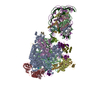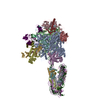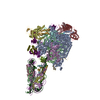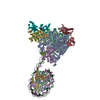[English] 日本語
 Yorodumi
Yorodumi- PDB-8he5: RNA polymerase II elongation complex bound with Rad26 and Elf1, s... -
+ Open data
Open data
- Basic information
Basic information
| Entry | Database: PDB / ID: 8he5 | |||||||||||||||||||||||||||
|---|---|---|---|---|---|---|---|---|---|---|---|---|---|---|---|---|---|---|---|---|---|---|---|---|---|---|---|---|
| Title | RNA polymerase II elongation complex bound with Rad26 and Elf1, stalled at SHL(-3.5) of the nucleosome | |||||||||||||||||||||||||||
 Components Components |
| |||||||||||||||||||||||||||
 Keywords Keywords | TRANSCRIPTION / RNA / DNA / Repair | |||||||||||||||||||||||||||
| Function / homology |  Function and homology information Function and homology informationregulation of septum digestion after cytokinesis / siRNA-mediated pericentric heterochromatin formation / RPB4-RPB7 complex / nuclear-transcribed mRNA catabolic process, deadenylation-dependent decay / termination of RNA polymerase II transcription / termination of RNA polymerase III transcription / positive regulation of nuclear-transcribed mRNA poly(A) tail shortening / transcription initiation at RNA polymerase III promoter / termination of RNA polymerase I transcription / transcription initiation at RNA polymerase I promoter ...regulation of septum digestion after cytokinesis / siRNA-mediated pericentric heterochromatin formation / RPB4-RPB7 complex / nuclear-transcribed mRNA catabolic process, deadenylation-dependent decay / termination of RNA polymerase II transcription / termination of RNA polymerase III transcription / positive regulation of nuclear-transcribed mRNA poly(A) tail shortening / transcription initiation at RNA polymerase III promoter / termination of RNA polymerase I transcription / transcription initiation at RNA polymerase I promoter / RNA polymerase II complex binding / maintenance of transcriptional fidelity during transcription elongation by RNA polymerase II / positive regulation of translational initiation / negative regulation of tumor necrosis factor-mediated signaling pathway / ATP-dependent activity, acting on DNA / RNA polymerase I complex / transcription elongation by RNA polymerase I / RNA polymerase III complex / pericentric heterochromatin / negative regulation of megakaryocyte differentiation / RNA polymerase II, core complex / tRNA transcription by RNA polymerase III / protein localization to CENP-A containing chromatin / transcription by RNA polymerase I / Replacement of protamines by nucleosomes in the male pronucleus / CENP-A containing nucleosome / translation initiation factor binding / Packaging Of Telomere Ends / transcription-coupled nucleotide-excision repair / Recognition and association of DNA glycosylase with site containing an affected purine / Cleavage of the damaged purine / Deposition of new CENPA-containing nucleosomes at the centromere / telomere organization / Recognition and association of DNA glycosylase with site containing an affected pyrimidine / Cleavage of the damaged pyrimidine / RNA Polymerase I Promoter Opening / Inhibition of DNA recombination at telomere / Assembly of the ORC complex at the origin of replication / Meiotic synapsis / SUMOylation of chromatin organization proteins / Regulation of endogenous retroelements by the Human Silencing Hub (HUSH) complex / DNA methylation / Condensation of Prophase Chromosomes / Chromatin modifications during the maternal to zygotic transition (MZT) / SIRT1 negatively regulates rRNA expression / HCMV Late Events / transcription elongation factor complex / ERCC6 (CSB) and EHMT2 (G9a) positively regulate rRNA expression / PRC2 methylates histones and DNA / innate immune response in mucosa / Regulation of endogenous retroelements by KRAB-ZFP proteins / Defective pyroptosis / HDACs deacetylate histones / Regulation of endogenous retroelements by Piwi-interacting RNAs (piRNAs) / transcription initiation at RNA polymerase II promoter / transcription elongation by RNA polymerase II / Nonhomologous End-Joining (NHEJ) / RNA Polymerase I Promoter Escape / lipopolysaccharide binding / P-body / Transcriptional regulation by small RNAs / Formation of the beta-catenin:TCF transactivating complex / Activated PKN1 stimulates transcription of AR (androgen receptor) regulated genes KLK2 and KLK3 / RUNX1 regulates genes involved in megakaryocyte differentiation and platelet function / HDMs demethylate histones / G2/M DNA damage checkpoint / NoRC negatively regulates rRNA expression / B-WICH complex positively regulates rRNA expression / PKMTs methylate histone lysines / DNA Damage/Telomere Stress Induced Senescence / Pre-NOTCH Transcription and Translation / Meiotic recombination / ribonucleoside binding / Metalloprotease DUBs / Activation of anterior HOX genes in hindbrain development during early embryogenesis / RMTs methylate histone arginines / Transcriptional regulation of granulopoiesis / DNA-directed RNA polymerase / HCMV Early Events / antimicrobial humoral immune response mediated by antimicrobial peptide / structural constituent of chromatin / DNA-directed RNA polymerase activity / UCH proteinases / antibacterial humoral response / heterochromatin formation / nucleosome / nucleosome assembly / single-stranded DNA binding / E3 ubiquitin ligases ubiquitinate target proteins / Recruitment and ATM-mediated phosphorylation of repair and signaling proteins at DNA double strand breaks / HATs acetylate histones / RUNX1 regulates transcription of genes involved in differentiation of HSCs / MLL4 and MLL3 complexes regulate expression of PPARG target genes in adipogenesis and hepatic steatosis / chromatin organization / Processing of DNA double-strand break ends / Senescence-Associated Secretory Phenotype (SASP) / Oxidative Stress Induced Senescence / defense response to Gram-negative bacterium / killing of cells of another organism / Estrogen-dependent gene expression Similarity search - Function | |||||||||||||||||||||||||||
| Biological species |  Komagataella phaffii (fungus) Komagataella phaffii (fungus) Homo sapiens (human) Homo sapiens (human)synthetic construct (others) | |||||||||||||||||||||||||||
| Method | ELECTRON MICROSCOPY / single particle reconstruction / cryo EM / Resolution: 6.95 Å | |||||||||||||||||||||||||||
 Authors Authors | Osumi, K. / Kujirai, T. / Ehara, H. / Kinoshita, C. / Saotome, M. / Kagawa, W. / Sekine, S. / Takizawa, Y. / Kurumizaka, H. | |||||||||||||||||||||||||||
| Funding support |  Japan, 8items Japan, 8items
| |||||||||||||||||||||||||||
 Citation Citation |  Journal: J Mol Biol / Year: 2023 Journal: J Mol Biol / Year: 2023Title: Structural Basis of Damaged Nucleotide Recognition by Transcribing RNA Polymerase II in the Nucleosome. Authors: Ken Osumi / Tomoya Kujirai / Haruhiko Ehara / Mitsuo Ogasawara / Chiaki Kinoshita / Mika Saotome / Wataru Kagawa / Shun-Ichi Sekine / Yoshimasa Takizawa / Hitoshi Kurumizaka /  Abstract: In transcription-coupled repair (TCR), transcribing RNA polymerase II (RNAPII) stalls at a DNA lesion and recruits TCR proteins to the damaged site. However, the mechanism by which RNAPII recognizes ...In transcription-coupled repair (TCR), transcribing RNA polymerase II (RNAPII) stalls at a DNA lesion and recruits TCR proteins to the damaged site. However, the mechanism by which RNAPII recognizes a DNA lesion in the nucleosome remains enigmatic. In the present study, we inserted an apurinic/apyrimidinic DNA lesion analogue, tetrahydrofuran (THF), in the nucleosomal DNA, where RNAPII stalls at the SHL(-4), SHL(-3.5), and SHL(-3) positions, and determined the structures of these complexes by cryo-electron microscopy. In the RNAPII-nucleosome complex stalled at SHL(-3.5), the nucleosome orientation relative to RNAPII is quite different from those in the SHL(-4) and SHL(-3) complexes, which have nucleosome orientations similar to naturally paused RNAPII-nucleosome complexes. Furthermore, we found that an essential TCR protein, Rad26 (CSB), enhances the RNAPII processivity, and consequently augments the DNA damage recognition efficiency of RNAPII in the nucleosome. The cryo-EM structure of the Rad26-RNAPII-nucleosome complex revealed that Rad26 binds to the stalled RNAPII through a novel interface, which is completely different from those previously reported. These structures may provide important information to understand the mechanism by which RNAPII recognizes the nucleosomal DNA lesion and recruits TCR proteins to the stalled RNAPII on the nucleosome. | |||||||||||||||||||||||||||
| History |
|
- Structure visualization
Structure visualization
| Structure viewer | Molecule:  Molmil Molmil Jmol/JSmol Jmol/JSmol |
|---|
- Downloads & links
Downloads & links
- Download
Download
| PDBx/mmCIF format |  8he5.cif.gz 8he5.cif.gz | 1.1 MB | Display |  PDBx/mmCIF format PDBx/mmCIF format |
|---|---|---|---|---|
| PDB format |  pdb8he5.ent.gz pdb8he5.ent.gz | 872.9 KB | Display |  PDB format PDB format |
| PDBx/mmJSON format |  8he5.json.gz 8he5.json.gz | Tree view |  PDBx/mmJSON format PDBx/mmJSON format | |
| Others |  Other downloads Other downloads |
-Validation report
| Summary document |  8he5_validation.pdf.gz 8he5_validation.pdf.gz | 1.6 MB | Display |  wwPDB validaton report wwPDB validaton report |
|---|---|---|---|---|
| Full document |  8he5_full_validation.pdf.gz 8he5_full_validation.pdf.gz | 1.6 MB | Display | |
| Data in XML |  8he5_validation.xml.gz 8he5_validation.xml.gz | 134.1 KB | Display | |
| Data in CIF |  8he5_validation.cif.gz 8he5_validation.cif.gz | 220.1 KB | Display | |
| Arichive directory |  https://data.pdbj.org/pub/pdb/validation_reports/he/8he5 https://data.pdbj.org/pub/pdb/validation_reports/he/8he5 ftp://data.pdbj.org/pub/pdb/validation_reports/he/8he5 ftp://data.pdbj.org/pub/pdb/validation_reports/he/8he5 | HTTPS FTP |
-Related structure data
| Related structure data |  34685MC  7wbvC  7wbwC  7wbxC C: citing same article ( M: map data used to model this data |
|---|---|
| Similar structure data | Similarity search - Function & homology  F&H Search F&H Search |
- Links
Links
- Assembly
Assembly
| Deposited unit | 
|
|---|---|
| 1 |
|
- Components
Components
-DNA-directed RNA polymerase ... , 3 types, 3 molecules ABI
| #1: Protein | Mass: 194107.422 Da / Num. of mol.: 1 / Source method: isolated from a natural source / Source: (natural)  Komagataella phaffii (fungus) / References: UniProt: C4R4Y0, DNA-directed RNA polymerase Komagataella phaffii (fungus) / References: UniProt: C4R4Y0, DNA-directed RNA polymerase |
|---|---|
| #2: Protein | Mass: 139746.094 Da / Num. of mol.: 1 / Source method: isolated from a natural source / Source: (natural)  Komagataella phaffii (fungus) / References: UniProt: C4QZQ7, DNA-directed RNA polymerase Komagataella phaffii (fungus) / References: UniProt: C4QZQ7, DNA-directed RNA polymerase |
| #9: Protein | Mass: 13612.320 Da / Num. of mol.: 1 / Source method: isolated from a natural source / Source: (natural)  Komagataella phaffii (fungus) / References: UniProt: F2QPE6 Komagataella phaffii (fungus) / References: UniProt: F2QPE6 |
-RNA polymerase II ... , 4 types, 4 molecules CDGK
| #3: Protein | Mass: 34216.293 Da / Num. of mol.: 1 / Source method: isolated from a natural source / Source: (natural)  Komagataella phaffii (fungus) / References: UniProt: C4R7L2 Komagataella phaffii (fungus) / References: UniProt: C4R7L2 |
|---|---|
| #4: Protein | Mass: 20622.980 Da / Num. of mol.: 1 / Source method: isolated from a natural source / Source: (natural)  Komagataella phaffii (fungus) / References: UniProt: C4R2U9 Komagataella phaffii (fungus) / References: UniProt: C4R2U9 |
| #7: Protein | Mass: 18802.625 Da / Num. of mol.: 1 / Source method: isolated from a natural source / Source: (natural)  Komagataella phaffii (fungus) / References: UniProt: C4R9A1 Komagataella phaffii (fungus) / References: UniProt: C4R9A1 |
| #11: Protein | Mass: 13832.896 Da / Num. of mol.: 1 / Source method: isolated from a natural source / Source: (natural)  Komagataella phaffii (fungus) / References: UniProt: C4R3Z5 Komagataella phaffii (fungus) / References: UniProt: C4R3Z5 |
-DNA-directed RNA polymerases I, II, and III subunit ... , 2 types, 2 molecules EH
| #5: Protein | Mass: 24962.680 Da / Num. of mol.: 1 / Source method: isolated from a natural source / Source: (natural)  Komagataella phaffii (fungus) / References: UniProt: C4R3P8 Komagataella phaffii (fungus) / References: UniProt: C4R3P8 |
|---|---|
| #8: Protein | Mass: 16249.220 Da / Num. of mol.: 1 / Source method: isolated from a natural source / Source: (natural)  Komagataella phaffii (fungus) / References: UniProt: C4R273 Komagataella phaffii (fungus) / References: UniProt: C4R273 |
-Protein , 7 types, 11 molecules FMOaebfcgdh
| #6: Protein | Mass: 17803.588 Da / Num. of mol.: 1 / Source method: isolated from a natural source / Source: (natural)  Komagataella phaffii (fungus) / References: UniProt: C4R1V1 Komagataella phaffii (fungus) / References: UniProt: C4R1V1 | ||||||
|---|---|---|---|---|---|---|---|
| #13: Protein | Mass: 12606.896 Da / Num. of mol.: 1 Source method: isolated from a genetically manipulated source Source: (gene. exp.)  Komagataella phaffii (fungus) / Production host: Komagataella phaffii (fungus) / Production host:  | ||||||
| #15: Protein | Mass: 125503.984 Da / Num. of mol.: 1 Source method: isolated from a genetically manipulated source Source: (gene. exp.)  Komagataella phaffii (fungus) Komagataella phaffii (fungus)Strain: ATCC 76273 / CBS 7435 / CECT 11047 / NRRL Y-11430 / Wegner 21-1 Gene: RAD26, PP7435_Chr2-0651 / Production host:  | ||||||
| #18: Protein | Mass: 15735.445 Da / Num. of mol.: 2 Source method: isolated from a genetically manipulated source Source: (gene. exp.)  Homo sapiens (human) / Production host: Homo sapiens (human) / Production host:  #19: Protein | Mass: 11676.703 Da / Num. of mol.: 2 Source method: isolated from a genetically manipulated source Source: (gene. exp.)  Homo sapiens (human) / Gene: H4C1 / Production host: Homo sapiens (human) / Gene: H4C1 / Production host:  #20: Protein | Mass: 14447.825 Da / Num. of mol.: 2 Source method: isolated from a genetically manipulated source Source: (gene. exp.)  Homo sapiens (human) / Gene: H2AC4, H2AFM, HIST1H2AB, H2AC8, H2AFA, HIST1H2AE / Production host: Homo sapiens (human) / Gene: H2AC4, H2AFM, HIST1H2AB, H2AC8, H2AFA, HIST1H2AE / Production host:  #21: Protein | Mass: 14217.516 Da / Num. of mol.: 2 Source method: isolated from a genetically manipulated source Source: (gene. exp.)  Homo sapiens (human) / Gene: H2BC11, H2BFR, HIST1H2BJ / Production host: Homo sapiens (human) / Gene: H2BC11, H2BFR, HIST1H2BJ / Production host:  |
-RNA polymerase subunit ABC10- ... , 2 types, 2 molecules JL
| #10: Protein | Mass: 8554.064 Da / Num. of mol.: 1 / Source method: isolated from a natural source / Source: (natural)  Komagataella phaffii (fungus) / References: UniProt: C4R009 Komagataella phaffii (fungus) / References: UniProt: C4R009 |
|---|---|
| #12: Protein | Mass: 7862.048 Da / Num. of mol.: 1 / Source method: isolated from a natural source / Source: (natural)  Komagataella phaffii (fungus) / References: UniProt: F2QMI1 Komagataella phaffii (fungus) / References: UniProt: F2QMI1 |
-DNA chain , 2 types, 2 molecules NT
| #14: DNA chain | Mass: 61381.906 Da / Num. of mol.: 1 / Source method: obtained synthetically / Source: (synth.) synthetic construct (others) |
|---|---|
| #17: DNA chain | Mass: 60845.949 Da / Num. of mol.: 1 / Source method: obtained synthetically / Source: (synth.) synthetic construct (others) |
-RNA chain , 1 types, 1 molecules P
| #16: RNA chain | Mass: 4969.832 Da / Num. of mol.: 1 / Source method: obtained synthetically / Source: (synth.) synthetic construct (others) |
|---|
-Non-polymers , 2 types, 10 molecules 


| #22: Chemical | ChemComp-ZN / #23: Chemical | ChemComp-MG / | |
|---|
-Details
| Has ligand of interest | Y |
|---|
-Experimental details
-Experiment
| Experiment | Method: ELECTRON MICROSCOPY |
|---|---|
| EM experiment | Aggregation state: PARTICLE / 3D reconstruction method: single particle reconstruction |
- Sample preparation
Sample preparation
| Component |
| ||||||||||||||||||||||||||||||||||||||||||
|---|---|---|---|---|---|---|---|---|---|---|---|---|---|---|---|---|---|---|---|---|---|---|---|---|---|---|---|---|---|---|---|---|---|---|---|---|---|---|---|---|---|---|---|
| Source (natural) |
| ||||||||||||||||||||||||||||||||||||||||||
| Source (recombinant) |
| ||||||||||||||||||||||||||||||||||||||||||
| Buffer solution | pH: 7.5 | ||||||||||||||||||||||||||||||||||||||||||
| Specimen | Embedding applied: NO / Shadowing applied: NO / Staining applied: NO / Vitrification applied: YES | ||||||||||||||||||||||||||||||||||||||||||
| Vitrification | Cryogen name: ETHANE |
- Electron microscopy imaging
Electron microscopy imaging
| Experimental equipment |  Model: Titan Krios / Image courtesy: FEI Company |
|---|---|
| Microscopy | Model: FEI TITAN KRIOS |
| Electron gun | Electron source:  FIELD EMISSION GUN / Accelerating voltage: 300 kV / Illumination mode: FLOOD BEAM FIELD EMISSION GUN / Accelerating voltage: 300 kV / Illumination mode: FLOOD BEAM |
| Electron lens | Mode: BRIGHT FIELD / Nominal defocus max: 2500 nm / Nominal defocus min: 1000 nm |
| Image recording | Electron dose: 57.6 e/Å2 / Film or detector model: GATAN K3 BIOQUANTUM (6k x 4k) |
- Processing
Processing
| Software |
| ||||||||||||||||||||||||
|---|---|---|---|---|---|---|---|---|---|---|---|---|---|---|---|---|---|---|---|---|---|---|---|---|---|
| CTF correction | Type: PHASE FLIPPING AND AMPLITUDE CORRECTION | ||||||||||||||||||||||||
| 3D reconstruction | Resolution: 6.95 Å / Resolution method: FSC 0.143 CUT-OFF / Num. of particles: 29751 / Symmetry type: POINT | ||||||||||||||||||||||||
| Refinement | Cross valid method: NONE Stereochemistry target values: GeoStd + Monomer Library + CDL v1.2 | ||||||||||||||||||||||||
| Displacement parameters | Biso mean: 612.64 Å2 | ||||||||||||||||||||||||
| Refine LS restraints |
|
 Movie
Movie Controller
Controller





 PDBj
PDBj




































































